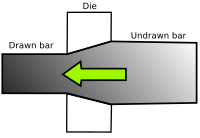
Photo from wikipedia
Abstract Wire feed speeds of 3.5, 4.5, and 5.5 m/min and offset positions of 1 and 2 were employed for this study with an ERCuSi-A weld wire. The microstructures of the… Click to show full abstract
Abstract Wire feed speeds of 3.5, 4.5, and 5.5 m/min and offset positions of 1 and 2 were employed for this study with an ERCuSi-A weld wire. The microstructures of the joints, which include a Cu/Ti interface layer consisting of Ti2Cu, TiCu, and AlCu2Ti, a Cu-matrix seam consisting of Cu and petal-shaped Fe-Si-Ti intermetallics, and a Cu/Fe interface layer consisting of α-Fe and Cu, were studied. The formation enthalpy calculated from the Miedema model can explained the microstructure evolution mechanism. The interface thickness and ultimate tensile strength were found to increase with wire feed speed. The highest tensile strength of the joint was 294 MPa, fracturing at the Cu/Ti interface. Offsetting the welding torch to the TC4 side increased the amount and size of the Fe-Si-Ti intermetallics, degrading the tensile strength. Four fracture modes were proposed to differentiate the crack propagations in the joints, which were determined by the interfacial bonding strength and the Fe-Si-Ti intermetallics in the weld seam.
Journal Title: Journal of Materials Processing Technology
Year Published: 2019
Link to full text (if available)
Share on Social Media: Sign Up to like & get
recommendations!